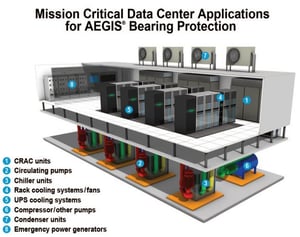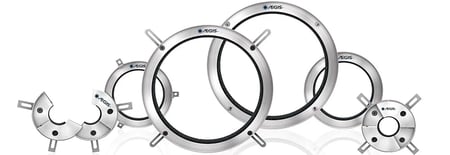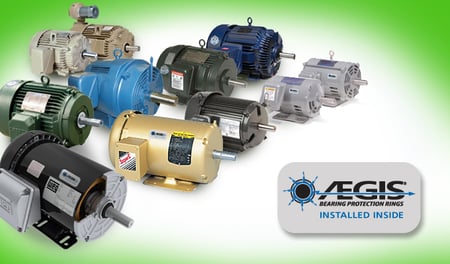Variable frequency drives (VFDs) are widely used in data center cooling applications because they offer precise control of motor speed and significant energy savings. Without variable speed control, a motor can either run at full speed or not at all. Most applications don't need constant full-speed motor operation, so that wastes energy. With VFD control, though, motors are run only as fast as the situation demands. In HVAC applications, this can give energy savings of up to 30%. And 30% of the power for a data center's cooling amounts to a lot of money saved.
 Here is a partial list of the cooling equipment that can be driven by VFD, when the motors are protected by AEGIS rings.
Here is a partial list of the cooling equipment that can be driven by VFD, when the motors are protected by AEGIS rings. But though savings are great, they aren't everything. Reliability is even more important in a data center. And VFDs are unfortunately bad for motor reliability. To start with, they can burn out the windings of motors with low-grade insulation. Nowadays, though, most motors come with inverter-ready or inverter-duty winding insulation, which can tolerate the stresses of VFD control. But winding damage isn't the only risk of VFD control.
VFDs can also destroy the bearings of the motors they control. They do this by generating a voltage between the motor's rotor and stator frame. This so-called shaft voltage tends to discharge or arc through the motor bearings. This arcing can occur thousands of times per second, and every arc leaves an invisibly tiny crater behind. Over time, these craters accumulate and roughen the smooth surfaces of the bearing. This causes noise, vibration, and eventual bearing failure. The bearings of motors on VFDs can sometimes fail in only a few months.
When a bearing has failed, there are two options. You can replace the bearing, or just buy a new motor. Neither option is especially cheap. And one data center might have hundreds of motors under VFD control. The costs can add up fast, and even cancel out the energy savings from using VFDs.
Clearly, some form of bearing protection is needed. One way to protect the bearings is to ground the shaft with a low-resistance brush. Charge preferentially flows through the device instead of through a bearing.
 AEGIS Shaft Grounding Rings
AEGIS Shaft Grounding RingsOne popular and effective shaft grounding device is the AEGIS Shaft Grounding Ring. AEGIS rings surround the motor shaft with hundreds of thousands of conductive microfibers. The microfibers bleed off shaft voltage before it builds up enough to arc through the bearings. AEGIS rings work in most environments without maintenance or appreciable wear. Testing has shown that they wear only 0.001" in 10,000 hours of operation. Extrapolating, gives the grounding rings an operating lifetime of 200,000 hours. That's about twice the L10 lifetime of a typical bearing.
With AEGIS rings installed, VFD-fed motors are safe from electrical bearing damage. By using AEGIS rings, data centers can reap the savings promised by VFDs, without the risk of unexpected repair and replacement costs.
 A selection of motors with AEGIS rings factory-installed.
A selection of motors with AEGIS rings factory-installed. AEGIS rings can easily be installed externally. But since they last so long and rarely need maintenance, they can also be installed inside motors. Internal installation protects the rings from contamination and makes them even more reliable. And buying a new motor with AEGIS installed is the easiest way to get protection. Several major motor manufacturers have lines of stock motors with AEGIS rings installed internally. These include ABB (Baldor), WEG, Marathon, Leeson, and US Motors Varitough™ condenser motors. A new website, industrialmatrix.com, has a searchable database of hundreds of motors with AEGIS installed (inside and out). This is probably the best way to find a motor with AEGIS that's suitable for your application.
AEGIS Rings also come with a 2-year extended warranty against bearing fluting damage. No other form of protection against VFD-caused bearing damage offers a warranty like this.

To learn more about AEGIS shaft grounding and best practices for electrical bearing protection, sign up for a training. We offer monthly live training webinars, and - pandemic restrictions permitting - we can also visit your facility to review your exact application.
This article was adapted from this white paper.


